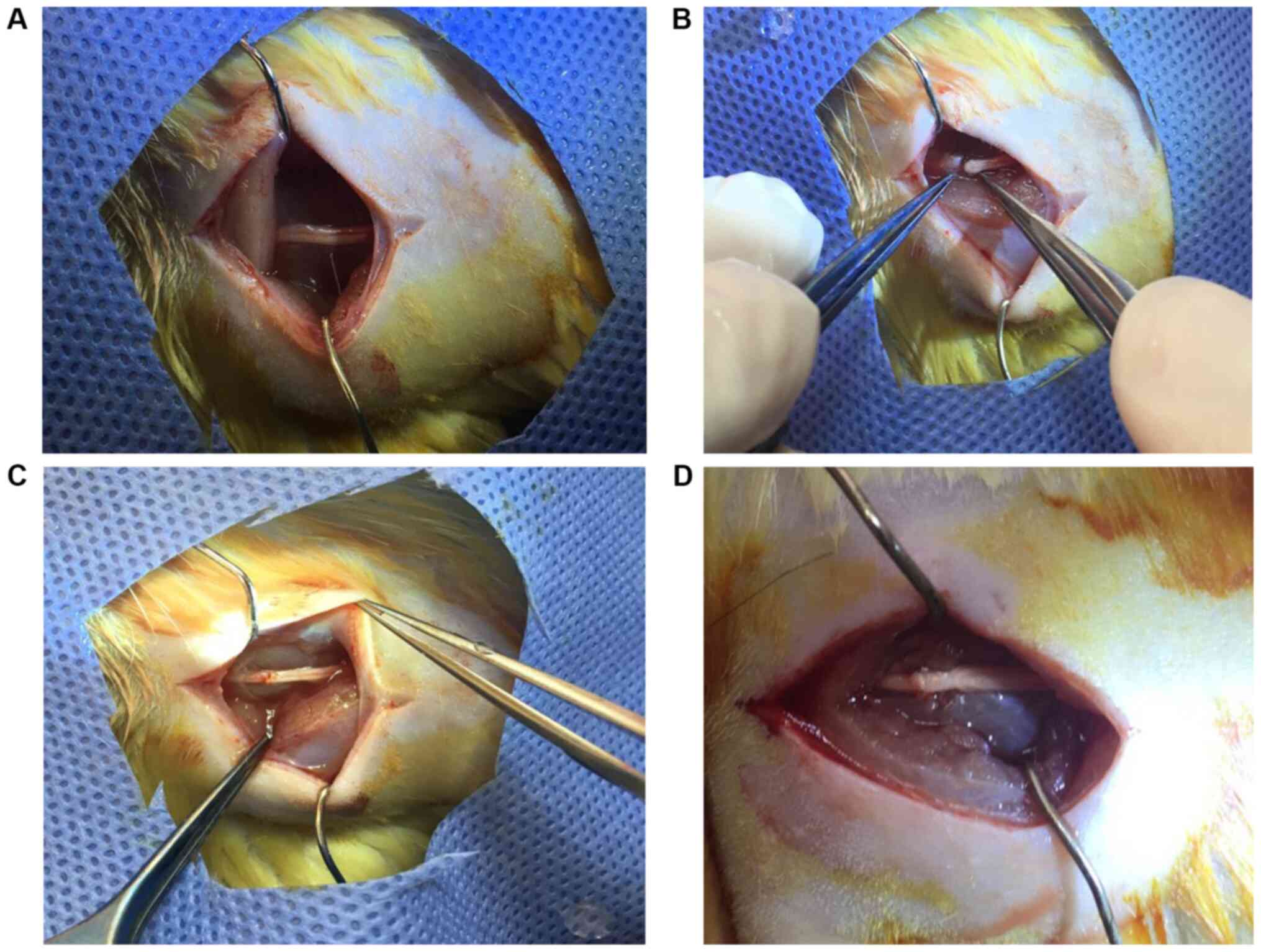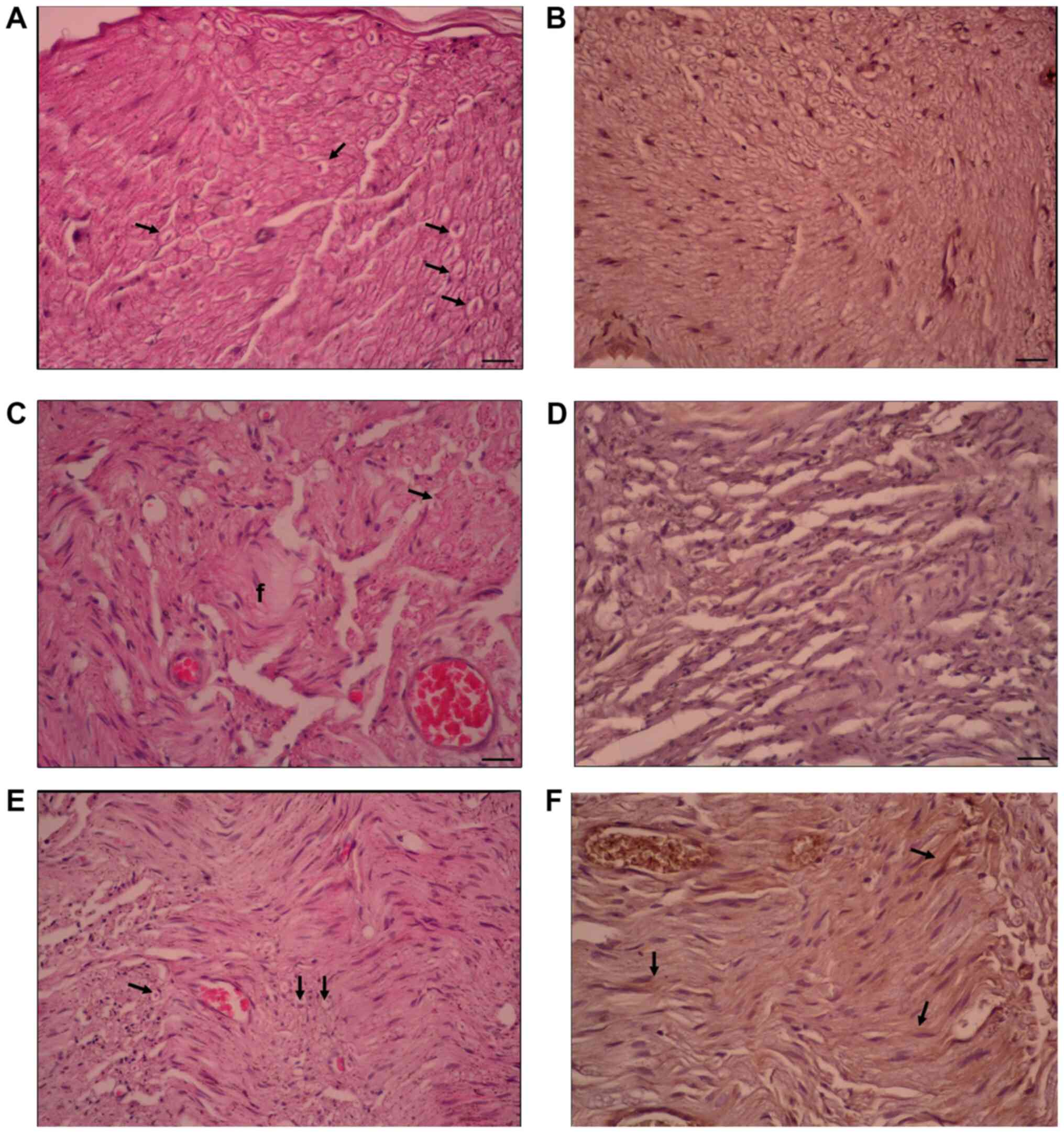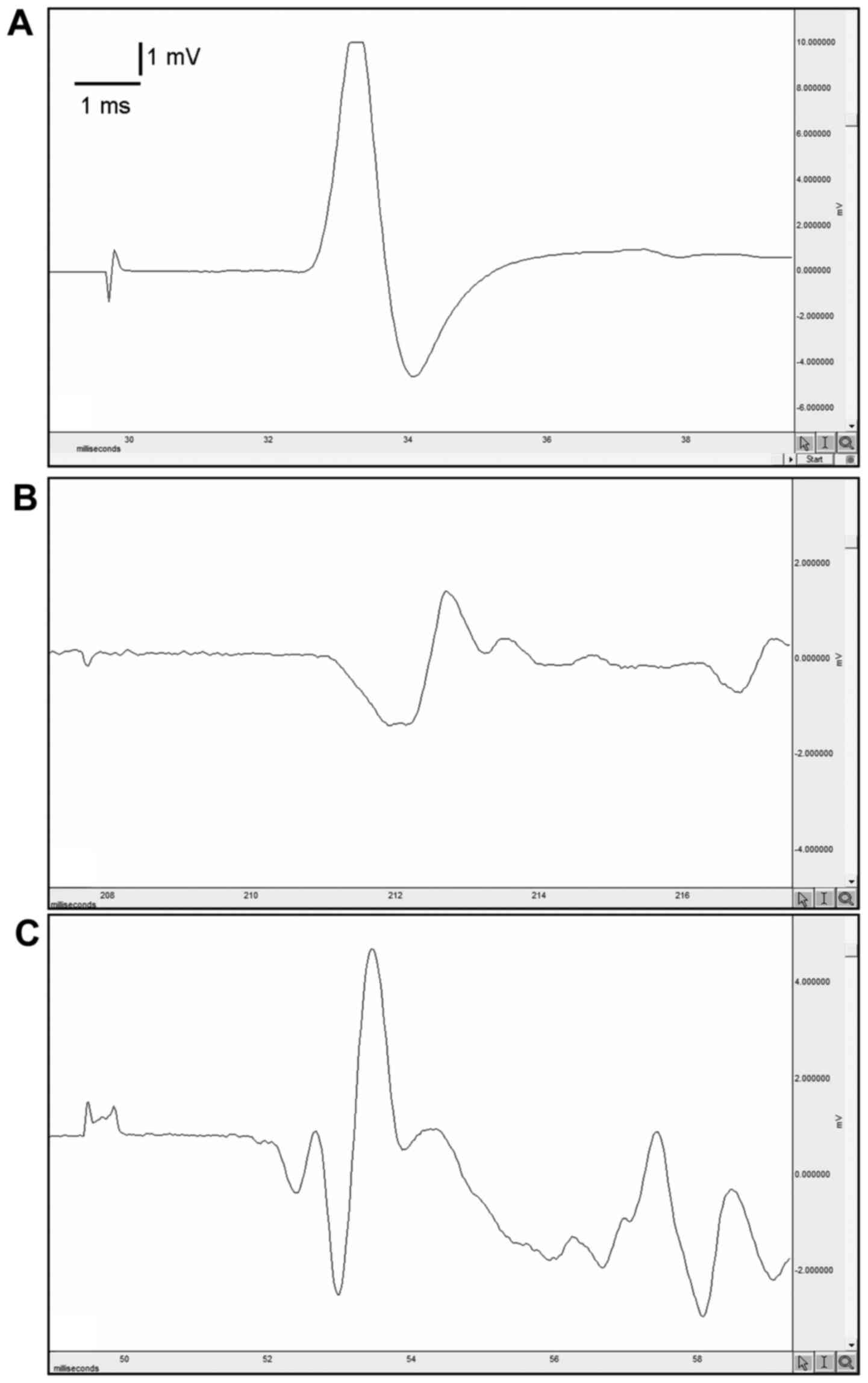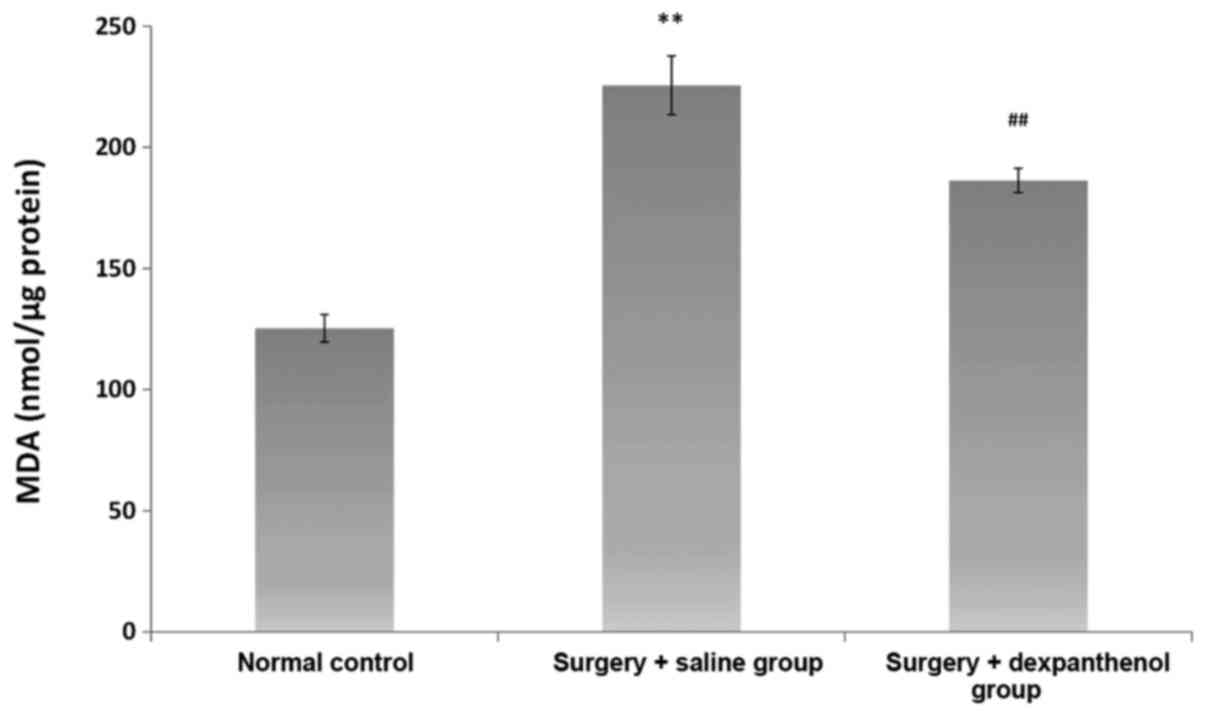|
1
|
Brandon WS, Sarada S, David AS, Jacob RJ,
Lynda JS and Thomas JW: An update on the management of adult
traumatic nerve injuries-replacing old paradigms: A review. J
Trauma Acute Care Surg. 86:299–306. 2019.PubMed/NCBI View Article : Google Scholar
|
|
2
|
Rasulić L, Simić V, Savić A, Lepić M,
Kovačević V, Puzović V, Vitošević F, Novaković N, Samardžić M and
Rotim K: Management of brachial plexus missile injuries. Acta Clin
Croat. 57:487–496. 2018.PubMed/NCBI View Article : Google Scholar
|
|
3
|
Kline DG, Kim D, Midha R, Harsh C and Tiel
R: Management and results of sciatic nerve injuries: A 24-year
experience. J Neurosurg. 89:13–23. 1998.PubMed/NCBI View Article : Google Scholar
|
|
4
|
Mark LW, Michael R, Jack GG and Pedro KB:
Peripheral nerve injury, scarring, and recovery. Connect Tissue
Res. 60:3–9. 2019.PubMed/NCBI View Article : Google Scholar
|
|
5
|
Cho HH, Jang S, Lee SC, Jeong HS, Park JS,
Han JY, Lee KH and Cho YB: Effect of neural-induced mesenchymal
stem cells and platelet-rich plasma on facial nerve regeneration in
an acute nerve injury model. Laryngoscope. 120:907–913.
2010.PubMed/NCBI View Article : Google Scholar
|
|
6
|
Yin ZS, Zhang H, Bo W and Gao W:
Erythropoietin promotes functional recovery and enhances nerve
regeneration after peripheral nerve injury in rats. AJNR Am J
Neuroradiol. 31:509–515. 2010.PubMed/NCBI View Article : Google Scholar
|
|
7
|
Mahanthappa NK, Anton ES and Matthew WD:
Glial growth factor 2, a soluble neuregulin, directly increases
Schwann cell motility and indirectly promotes neurite outgrowth. J
Neurosci. 16:4673–683. 1996.PubMed/NCBI View Article : Google Scholar
|
|
8
|
Ghoraba SM, Mahmoud WH, Elsergany MA and
Ayad HM: Ulnar nerve injuries (Sunderland Grade V): A simplified
classification system and treatment algorithm. Plast Reconstr Surg
Glob Open. 7(e2474)2019.PubMed/NCBI View Article : Google Scholar
|
|
9
|
Tulaci KG, Tuzuner A, Karadas Emir H,
Tatar İ, Sargon MF, Tulaci T, Karadavut Y and Samim EE: The effect
of tacrolimus on facial nerve injury: Histopathological findings in
a rabbit model. Am J Otolaryngol. 37:393–397. 2016.PubMed/NCBI View Article : Google Scholar
|
|
10
|
Lopatina T, Kalinina N, Karagyaur M,
Stambolsky D, Rubina K, Revischin A, Pavlova G, Parfyonova Y and
Tkachuk V: Correction: Adipose-derived stem cells stimulate
regeneration of peripheral nerves: BDNF secreted by these cells
promotes nerve healing and axon growth de novo. PLoS One.
14(e0219946)2019.PubMed/NCBI View Article : Google Scholar
|
|
11
|
Klein SM, Vykoukal J, Li DP, Pan HL,
Zeitler K, Alt E, Geis S, Felthaus O and Prantl L: Peripheral motor
and sensory nerve conduction following transplantation of
undifferentiated autologous adipose tissue-derived stem cells in a
biodegradable U.S. food and drug administration-approved nerve
conduit. Plast Reconstr Surg. 138:132–139. 2016.PubMed/NCBI View Article : Google Scholar
|
|
12
|
Lars K, Barbara H and Doychin NA: The pros
and cons of growth factors and cytokines in peripheral axon
regeneration. Int Rev Neurobiol. 108:137–171. 2013.PubMed/NCBI View Article : Google Scholar
|
|
13
|
Karahan G, Kaya H, Erdogan MA, Yigitturk
G, Gokyayla E and Erbas O: Effects of trimetazidine on nerve
regeneration in a rat sciatic nerve injury model. Bratisl Lek
Listy. 120:777–782. 2019.PubMed/NCBI View Article : Google Scholar
|
|
14
|
Lundborg G: A 25-year perspective of
peripheral nerve surgery: Evolving neuroscientific concepts and
clinical significance. J Hand Surg Am. 25:391–414. 2000.PubMed/NCBI View Article : Google Scholar
|
|
15
|
Ogden M, Karaca SB, Aydin G, Yuksel U,
Dagli AT, Akkaya S and Bakar B: The healing effects of thymoquinone
and dexpanthenol in sciatic nerve compression injury in rats. J
Invest Surg. 1–9. 2019.PubMed/NCBI View Article : Google Scholar
|
|
16
|
Demougeot C, Marie C and Beley A:
Importance of iron location in iron-induced hydroxyl radical
production by brain slices. Life Sci. 67:399–410. 2000.PubMed/NCBI View Article : Google Scholar
|
|
17
|
Rivlin AS and Tator CH: Objective clinical
assessment of motor function after experimental spinal cord injury
in the rat. J Neurosurg. 47:577–581. 1977.PubMed/NCBI View Article : Google Scholar
|
|
18
|
Geuna S: The sciatic nerve injury model in
pre-clinical research. J Neurosci Methods. 243:39–46.
2015.PubMed/NCBI View Article : Google Scholar
|
|
19
|
Sunderland S, McArthur RA and Nam DA:
Repair of a transected sciatic nerve. A study of nerve regeneration
and functional recovery: Report of a case. J Bone Joint Surg Am.
75:911–914. 1993.PubMed/NCBI View Article : Google Scholar
|
|
20
|
Yardimci I, Karakan T, Resorlu B, Doluoglu
OG, Ozcan S, Aydın A, Demirbas A, Unverdi H and Eroglu M: The
effect of intraurethral dexpanthenol on healing and fibrosis in
rats with experimentally induced urethral trauma. Urology.
85:274.e9–13. 2015.PubMed/NCBI View Article : Google Scholar
|
|
21
|
Ermis H, Parlakpinar H, Gulbas G, Vardi N,
Polat A, Cetin A, Kilic T and Aytemur ZA: Protective effect of
dexpanthenol on bleomycin-induced pulmonary fibrosis in rats.
Naunyn Schmiedebergs Arch Pharmacol. 386:1103–1110. 2013.PubMed/NCBI View Article : Google Scholar
|
|
22
|
Dellon AL and Mackinnon SE: Selection of
the appropriate parameter to measure neural regeneration. Ann Plast
Surg. 23:197–202. 1989.PubMed/NCBI View Article : Google Scholar
|
|
23
|
Siqueira Mietto B, Kroner A, Girolami EI,
Santos-Nogueira E, Zhang J and David S: Role of IL-10 in resolution
of inflammation and functional recovery after peripheral nerve
injury. J Neurosci. 35:16431–442. 2015.PubMed/NCBI View Article : Google Scholar
|
|
24
|
Renno WM, Benov L and Khan KM: Possible
role of antioxidative capacity of (-)-epigallocatechin-3-gallate
treatment in morphological and neurobehavioral recovery after
sciatic nerve crush injury. J Neurosurg Spine. 27:593–613.
2017.PubMed/NCBI View Article : Google Scholar
|
|
25
|
Zhang L, Johnson D and Johnson JA:
Deletion of Nrf2 impairs functional recovery, reduces clearance of
myelin debris and decreases axonal remyelination after peripheral
nerve injury. Neurobiol Dis. 54:329–338. 2013.PubMed/NCBI View Article : Google Scholar
|
|
26
|
Draper HH and Hadley M: Malondialdehyde
determination as index of lipid Peroxidation. Methods Enzymol.
186:421–431. 1990.PubMed/NCBI View Article : Google Scholar
|
|
27
|
Tutun B, Elbe H, Vardi N, Parlakpinar H,
Polat A, Gunaltili M, Guclu MM and Yasar EN: Dexpanthenol reduces
diabetic nephropathy and renal oxidative stress in rats. Biotech
Histochem. 94:84–91. 2019.PubMed/NCBI View Article : Google Scholar
|
|
28
|
Etensel B, Ozkisacik S, Ozkara E, Karul A,
Oztan O, Yazici M and Gürsoy H: Dexpanthenol attenuates lipid
peroxidation and testicular damage at experimental ischemia and
reperfusion injury. Pediatr Surg Int. 23:177–181. 2007.PubMed/NCBI View Article : Google Scholar
|
|
29
|
Basso DM, Beattie MS and Bresnahan JC: A
sensitive and reliable locomotor rating scale for open field
testing in rats. J Neurotrauma. 12:1–21. 1995.PubMed/NCBI View Article : Google Scholar
|
|
30
|
Tarlov IM and Klinger H: Spinal cord
compression studies: II Time limits for recovery after acute
compression in dogs. AMA Arch Neurol Psychiatry. 71:271–290.
1954.PubMed/NCBI
|
|
31
|
Korkmaz MF, Parlakpinar H, Erdem MN,
Ceylan MF, Ediz L, Samdanci E and Kekilli E: The therapeutic
efficacy of dexpanthenol on sciatic nerve injury in a rat model. Br
J Neurosurg. 34:397–401. 2020.PubMed/NCBI View Article : Google Scholar
|
|
32
|
Kunkel-Bagden E, Dai HN and Bregman BS:
Methods to assess the development and recovery of locomotor
function after spinal cord injury in rats. Exp Neurol. 119:153–164.
1993.PubMed/NCBI View Article : Google Scholar
|


















